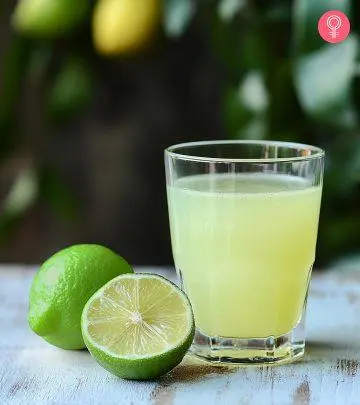Mamoncillo: Health Benefits, Nutritional Facts, And Recipes
Include this delicious fruit in your daily diet to transform your health!

Image: Midjourney/ StyleCraze Design Team
Have you ever seen a fruit that looks like lime on the outside and lychee on the inside? Well, chances are you might have come across mamoncillo, or Spanish limes, as they are popularly known. Mamoncillo or Melicoccus bijugatus are tiny green fruits that measure about 3-4 centimeters in diameter, are almost round in shape, and have a large white seed at the center of a gelatinous pulp (aril). Read on to know more about the availability, nutritional value, and health benefits of these non-citrus fruits, which are more commonly related to lychee and rambutan.
 Know Your Ingredient: Mamoncillo
Know Your Ingredient: MamoncilloWhat Is It?
A round-shaped, green-colored fruit that belongs to the Sapindaceae family native to South and Central America.
What Are Its Benefits?
May support digestive health, improve cardiovascular health, and combat hypertension.
Who Can Consume It?
Considered safe for general consumption.
How Often?
Regularly.
Caution
Excessive intake of mamoncillo may lead to bloating, nausea, and abdominal cramps.
In This Article
Geography, Seasons, And Availability Of Mamoncillo
Mamoncillos are little green fruits native to the Caribbean islands and northern South America. They primarily grow in the tropical regions of the Pacific and Africa. These little green fruits are commercially cultivated in the southern parts of Florida in the United States and are also found in a few of the home gardens. Today, it is popular in Central America, the Caribbean, and can also be found in India. Mamoncillo is also known by many other region-specific names like Spanish lime, guinep, genip, genipe, quenepa, ginepa, quenepe, chenet, mamon, canepa, skinip, or limoncillo.
Mamoncillos are usually found growing in clusters of 12 fruits or more on large green, leafy trees. These are usually available in the summer months and can be harvested from July to October.
 Fun Fact
Fun FactLet’s further see what these juicy fruits taste like and what nutritional benefits they offer.
Key Takeaways
- Mamoncillos are tiny green non-citrus fruits with a rich nutrient profile.
- The phenolic compounds in mamoncillo may help treat digestive issues and improve cardiovascular health.
- It is recommended to pluck fresh fruits from the branches when you consume them.
Taste And Nutritional Value
Mamoncillo usually tastes tangy when unripe and can be sweetly acidic with an underlying starchiness when ripe. The carbohydrates in the pulp make it sweet while the astringencyi A condition that causes the body tissues or skin cells to shrink. is due to its polyphenolic compounds. The taste is somewhere in between lychee and lime (1).
Mamoncillo is a good source of vitamins A and C, as well as fiber, phosphorus, and calcium.
These tiny fruits are also a good source of tryptophan, which helps produce serotonin (1), (2). The phenolic compounds in the mamoncillo pulp act as important antioxidants and have been traditionally used to help treat hypertensioni High blood pressure condition where the high blood flow forcefully hits the artery walls. and digestive issues in the Caribbean (1).
Let’s have a look at a few of its other key benefits.
Health Benefits Of Mamoncillo Fruit
- Antimicrobial Activity
The pulp extracts of mamoncillo exhibit antimicrobial activity based on their dose
. The pulp and embryo extracts also exhibit antifungal activity against a variety of yeast (1).
- Rich In Antioxidants

The edible pulp of mamoncillo shows high levels of antioxidant activity according to research. A 2014 study published in Food Chemistry analyzed the nutritional content and antioxidant activity of tropical fruits from Yucatan, Mexico. Researchers examined fruits like star apple, cashew, mombin, mamey sapote, white sapote, sugar apple, sapodilla, dragon fruit, nance, ilama, custard apple, mamoncillo, and black sapote. The findings showed that these fruits contain valuable bioactive compounds, with mamoncillo, star apple, mombin, cashew, and white sapote having the highest antioxidant activity. The study also found a strong link between phenol content and antioxidant properties, highlighting the potential health benefits of these tropical fruits (3). Antioxidants help the body get rid of toxic free radicals by boosting the immune system and also help reduce the risk of chronic diseases.
- May Support Cardiovascular Health

The phenolic compounds in mamoncillo might have cardioprotective properties as they help reduce your blood pressure by dilation of blood vessels. High blood pressure can damage your arteries by making them less elastic, which decreases the flow of blood and oxygen to your heart and leads to heart disease. Animal studies on rats fed with mamoncillo extracts report a reduction in systolic blood pressure (4). The extract was given for six weeks and was found to significantly reduce systolic, diastolic, and mean arterial pressure. It also helped relax blood vessels by acting on the endothelium (inner lining of blood vessels) through nitric oxide and guanylyl cyclase pathways, though it did not involve prostaglandins.
Further, the phenolics p-coumaric acid and caffeic acid seem to have anti-platelet activity which might help in blood clotting. Since these compounds exist in mamoncillo as well, its fruit extract may have potential benefits for managing high blood pressure, but more research is needed to confirm its effects in humans (5).
- May Help Improve Digestive Health

Mamoncillo seeds are traditionally used in Venezuela to help ease certain digestive health issues. They are roasted, crushed, and mixed with honey. This mix is then given to help stop diarrhea (1). The glucose to fructose ratio in mamoncillo extracts also seems to play a key role in helping ease gastrointestinal problemsi Issues affecting the gastrointestinal tract (pathway from the mouth, through the esophagus, stomach to the intestine) leading to nausea/vomiting, food poisoning, diarrhea and lactose intolerance. (6).
The mannacillo fruit’s many health advantages not only make it a nutrient-dense addition to your diet but also increase its versatility for a wide range of culinary applications. Scroll down to learn more.
Culinary Uses Of Mamoncillo
Here are some popular culinary uses of this versatile fruit:
- Adds a tangy element to salsas and chutneys, enhancing savory dishes.
- Offers a sweet-tart flavor when eaten fresh by peeling the skin.
- Blends perfectly into refreshing juices or smoothies.
- Enhances marinades and salad dressings with a zesty flavor.
- Incorporates well into desserts like fruit salads, sorbets, or ice creams.
- Can be pickled or made into preserves, serving as a sweet and tangy condiment.
With a range of such benefits, you might want to grow mamoncillo in your backyard. There are certain things that you should keep in mind to help you grow these trees better. Let’s check out what they are.
How To Grow Mamoncillo
Mamoncillo is usually well adapted to warm temperatures and subtropical climates. It is a tough tree that can withstand drought but is vulnerable to frost and extreme drops in temperatures.
You would need plenty of space to grow this tree, as it can reach up to 85ft in height. These should be planted in well-lit open spaces away from tall buildings or wires for best growth and fruit production. It does well on most soil types and is drought-tolerant as well. You need to water it regularly for the first four years. If you want to grow a Spanish lime tree, you should get a plant from a nearby nursery rather than starting from a seed. It takes 8-10 years to start bearing fruit so if you buy a grown plant, you can harvest the fruits in 4-5 years.
Sustainability Of Mamoncillo
Mamoncillo is widely grown in home backyards and wild varieties can be found all through the tropical and subtropical parts of America as well. Consequently, most fruits that appear in your farmer markets are, more often than not, grown without any chemical fertilizers or pesticides making them easily sustainable and environment-friendly.
Harvest And Ripening

Mamoncillo fruits grow and sell as clusters on their individual branches. The fruits should feel firm but not hard under the skin. Fruits that seem mushy or withered must have become overripe. You should also avoid fruits with bruised or broken skin.
Spanish lime trees can be harvested around June and July when they ripen and are ready to eat. The easiest way to eat them is to bite open the skin and suck on the pulp directly to get the most of the pulp and the juice.
Melanie, a YouTuber, shared her experience about trying mamoncillo. She said, “It tastes like a really mild warhead or something and similar to the tamarind flavor too. It’s sour but not like intensely sour like it’s unbearable (i).”
Some fruits might seem too tangy to eat directly and can be had with salt and chili powder. Mamoncillo’s seed is edible as well and can be eaten roasted, crushed, or mixed with honey.
 Did You Know?
Did You Know?Let’s further understand how you should store and preserve mamoncillos to make the most out of these tiny green fruits.
Storage And Preservation
You should let the fruits remain on the branches until you eat them. The fruits don’t ripen further after being picked, so you should try to eat them as early as possible. They can last for up to a week at room temperature, and may also be refrigerated if you prefer them cold.
Mamoncillo can be preserved fresh for up to 12 months by freezing the pulp of the peeled fruit in bags or airtight containers. As an alternative, you can boil the fruit with sugar to produce jams or preserves, which can be stored for up to a year in sealed jars.
Mamoncillo can be preserved for later use by soaking it in alcohol. They can also be made into jams and jellies. Let’s have a look at a few of its popular recipes.
Recipe Ideas
Mamoncillo is consumed mainly raw but there are few other ways to enjoy these fruits as well.
- Guinep (Mamoncillo) Juice

This is the easiest way to have a refreshing drink made of Spanish lime.
- Simply soak the mamoncillo fruits in water and separate the pulp from the seed with clean hands.
- Strain the juice and sweeten as per taste.
Next, we have another popular Caribbean drink made from Mamoncillo.
- Kenep (mamoncillo) Trempe
Kenep trempe refers to “rum-soaked kenep” wherein mamoncillo fruits are soaked in white rum with sugar, star anise, and cinnamon. You can choose to try a different flavor by adding vanilla beans instead of the lemon rind. You should use a bottle with a wide mouth and can enjoy this drink after 2 to 3 days of preparing it.
Ingredients
- Mason jar or bottle
- Kenep (mamoncillo)
- White rum – about 1 cup or more
- Cinnamon stick – 1-2
- Star anise – 1-2
- Sugar to taste
- Lemon rind – optional
- Vanilla bean – 1-2
Instructions
- Wash all the keneps and remove the skin.
- Place the seeds in a jar or bottle along with the flavoring spices.
- Add enough white rum to cover all the fruits.
- Add enough sugar to taste.
- Shake the bottle or jar to combine well.
- Let the keneps soak in rum for about 2 to 3 days.
 Did You Know?
Did You Know?To Sum Up
Mamoncillo or Spanish limes are tangy tropical fruits native to Caribbean islands. They are known by different names in various parts of the world. The trees need huge open spaces and plenty of sunshine to grow well. While the best way to enjoy the fruits and their benefits is by eating them raw, they can also be prepared and preserved as jams and jellies for later use.
Infographic: 4 Key Health Benefits Of Mamoncillo Fruit
The small, green, lime-like mamoncillo is packed with amazing nutrients. Apart from its gelatinous flesh, even the seeds can be cooked and consumed. This crispy and refreshing fruit makes for a great snack as it is fibrous and packed with many important nutrients that are essential for optimal health. Check out the infographic below to find out the benefits of devouring this fantastic fruit.

Illustration: StyleCraze Design Team
Frequently Asked Questions
How many calories are in a mamoncillo?
Mamoncillo is low in calories. A 100 g of edible portion contains only around 58 calories.
Is guinep good for diabetes?
It is said that certain proteins in guinep may help control diabetes. However, studies are being done to figure out whether guinep is an anti-diabetic food.
Are guinep seeds poisonous?
Guinep seeds may show toxicity if consumed unripe. These seeds are roasted before consumption to avoid toxicity.
Illustration: Mamoncillo: All You Need To Know

Image: Stable Diffusion/StyleCraze Design Team
Discover how best to enjoy the sweet and tart flavor of a Spanish lime! Watch this video for some easy ways to eat this delicious fruit and get the most out of its flavors.
Personal Experience: Source
StyleCraze's articles are interwoven with authentic personal narratives that provide depth and resonance to our content. Below are the sources of the personal accounts referenced in this article.
i. How to Eat a Spanish Lime (aka Quenepa/Mamoncillo)https://www.youtube.com/watch?v=SnX3rxrTgPk
References
Articles on StyleCraze are backed by verified information from peer-reviewed and academic research papers, reputed organizations, research institutions, and medical associations to ensure accuracy and relevance. Read our editorial policy to learn more.
- Melicoccus Bijugatus (guinep): Phytochemical Properties, Associated Health Benefits and Commercial Applications
https://www.tandfonline.com/doi/full/10.1080/15538362.2019.1669517# - Quenepa Sapindaceae Soapberry family
https://www.fs.fed.us/global/iitf/pubs/sm_iitf048%20%20(4).pdf - Determination of some physicochemical characteristics, bioactive compounds and antioxidant activity of tropical fruits from Yucatan, Mexico
https://pubmed.ncbi.nlm.nih.gov/24444968/ - Hypotensive and antihypertensive effects of an aqueous extract from Guinep fruit (Melicoccus bijugatus Jacq) in rats
https://pubmed.ncbi.nlm.nih.gov/33122667/ - Modulatory Effect of Guinep ( Melicoccus bijugatus Jacq) Fruit Pulp Extract on Isoproterenol-Induced Myocardial Damage in Rats. Identification of Major Metabolites Using High Resolution UHPLC Q-Orbitrap Mass Spectrometry
https://pubmed.ncbi.nlm.nih.gov/30634603/ - Phytochemical Profile, Toxicity, and Pharmacological Potential of Peels from Four Species of Tropical Fruits
https://pubmed.ncbi.nlm.nih.gov/29481311/
Read full bio of Rowinda Dimech
Read full bio of Varsha Patnaik
Read full bio of Ravi Teja Tadimalla
Read full bio of Payal Karnik
























Community Experiences
Join the conversation and become a part of our empowering community! Share your stories, experiences, and insights to connect with other beauty, lifestyle, and health enthusiasts.